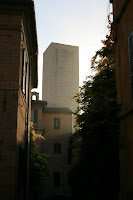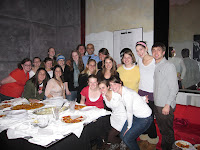 Why have such a distinguished people like the Italians chosen to represent themselves through their cuisine? Why could a humble food like pasta advance to become the most “Italian” food item? Umbra Professor Peter Fischer (History and Culture of Food in Italy) posed (and answered) these questions and others last night in his lecture. Fischer argued that starting with Artusi and his historical project of a “culinary Risorgimento” over the definition of a unified Italian cuisine in the Little Italies of early 20th century America, up to the development of a pronounced culinary conservatism in post WWII Italy, the construction of a common Italian culinary identity became the nucleus around which Italians where able to create a sense of distinction and resistance to cultural assimilation in a modernizing and globalizing world.
Why have such a distinguished people like the Italians chosen to represent themselves through their cuisine? Why could a humble food like pasta advance to become the most “Italian” food item? Umbra Professor Peter Fischer (History and Culture of Food in Italy) posed (and answered) these questions and others last night in his lecture. Fischer argued that starting with Artusi and his historical project of a “culinary Risorgimento” over the definition of a unified Italian cuisine in the Little Italies of early 20th century America, up to the development of a pronounced culinary conservatism in post WWII Italy, the construction of a common Italian culinary identity became the nucleus around which Italians where able to create a sense of distinction and resistance to cultural assimilation in a modernizing and globalizing world.
The lecture was well-attended by both Umbra students and faculty, as well as by the public. The lecture was part of a series, a collaboration between the Umbra Institute and a local foundation.


 graduating college.
graduating college. a Francesca (Duke of Urbino portrait). As stated in Turpin’s statement: “My paintings incorporate Renaissance themes and imagery, but superimpose not what was culturally acceptable in Renaissance times, but rather what we today as a culture publicly accept through our images of violence, sex, and drugs seen in our mass media. By exploring this dichotomy of Renaissance and modern popular culture, I hope the viewers can decide for themselves the trouble that might be associated with this type of blind societal acceptance of popular culture which has become so commonplace that we forget what implications it might have.”
a Francesca (Duke of Urbino portrait). As stated in Turpin’s statement: “My paintings incorporate Renaissance themes and imagery, but superimpose not what was culturally acceptable in Renaissance times, but rather what we today as a culture publicly accept through our images of violence, sex, and drugs seen in our mass media. By exploring this dichotomy of Renaissance and modern popular culture, I hope the viewers can decide for themselves the trouble that might be associated with this type of blind societal acceptance of popular culture which has become so commonplace that we forget what implications it might have.” sister city of Seattle, Washington. This video traces the history of Perugia back to the Etruscans, while also exploring issues of modernization in the city. Spend 26 minutes with host Mike James to learn more about the city, people, art, music, food, and shopping which provide the “human side of life” in Perugia.
sister city of Seattle, Washington. This video traces the history of Perugia back to the Etruscans, while also exploring issues of modernization in the city. Spend 26 minutes with host Mike James to learn more about the city, people, art, music, food, and shopping which provide the “human side of life” in Perugia. 




